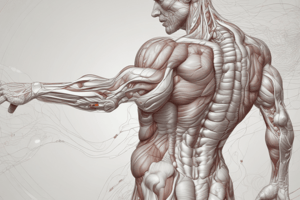Podcast
Questions and Answers
Which of the following conditions is characterized by muscle weakness and degeneration due to genetic factors?
Which of the following conditions is characterized by muscle weakness and degeneration due to genetic factors?
What physiological change occurs as a result of regular resistance training?
What physiological change occurs as a result of regular resistance training?
What is the main function of motor neurons at the neuromuscular junction?
What is the main function of motor neurons at the neuromuscular junction?
Endurance training primarily improves which aspect of muscle function?
Endurance training primarily improves which aspect of muscle function?
Signup and view all the answers
Which of the following best describes the role of sensory feedback in muscle activity?
Which of the following best describes the role of sensory feedback in muscle activity?
Signup and view all the answers
What initiates the muscle contraction process at the neuromuscular junction?
What initiates the muscle contraction process at the neuromuscular junction?
Signup and view all the answers
Which type of muscle fiber is primarily used for endurance activities?
Which type of muscle fiber is primarily used for endurance activities?
Signup and view all the answers
What is the role of calcium ions in muscle contraction?
What is the role of calcium ions in muscle contraction?
Signup and view all the answers
Which statement about the sliding filament theory is true?
Which statement about the sliding filament theory is true?
Signup and view all the answers
Which factor does NOT directly influence muscle strength?
Which factor does NOT directly influence muscle strength?
Signup and view all the answers
What happens to calcium ions after muscle contraction?
What happens to calcium ions after muscle contraction?
Signup and view all the answers
Fast-twitch fibers are characterized by which of the following?
Fast-twitch fibers are characterized by which of the following?
Signup and view all the answers
Which component of muscle performance is influenced by training?
Which component of muscle performance is influenced by training?
Signup and view all the answers
Study Notes
Structure and Function
- Skeletal muscle is a type of striated muscle tissue, a voluntary muscle type attached to bones via tendons.
- Muscles are responsible for movement, posture maintenance, and heat production.
- Muscle fibers (individual cells) are long, cylindrical, and multinucleated.
- Sarcomeres, the repeating units within muscle fibers, contain the contractile proteins actin and myosin.
- Myosin filaments are thick, with heads that interact with actin filaments during contraction.
- Actin filaments are thin, with binding sites for myosin.
- The sliding filament theory explains muscle contraction mechanics.
Muscle Contraction Mechanism
- Nerve impulses trigger acetylcholine release at the neuromuscular junction.
- Acetylcholine initiates a cascade culminating in calcium ion release from the sarcoplasmic reticulum.
- Calcium ions bind to troponin, causing tropomyosin to shift, exposing myosin-binding sites on actin.
- Myosin heads bind to actin, creating cross-bridges.
- ATP hydrolysis fuels the power stroke, where myosin pulls on actin filaments.
- The cycle repeats as long as calcium ions are present.
- Calcium ion reuptake into the sarcoplasmic reticulum causes muscle relaxation.
Types of Muscle Fibers
- Skeletal muscle fibers are classified as slow-twitch (Type I) or fast-twitch (Type II).
- Slow-twitch fibers are fatigue-resistant, used for endurance activities like long-distance running.
- Fast-twitch fibers contract rapidly but fatigue quickly, utilized for activities like sprinting and powerlifting.
- Fast-twitch subtypes (Type IIA and Type IIX) differ in contractile speed and metabolic properties.
Factors Affecting Muscle Performance
- Muscle strength depends on size, fiber type composition, and training.
- Muscle endurance relates to maintaining contractions over time.
- The nervous system controls muscle activity and force production.
- Adequate nutrient intake, particularly protein for growth and repair, is essential for optimal function.
- Hormone, electrolyte, and signaling molecule interactions regulate performance.
Muscle Disorders
- Muscle disorders range from injuries (strains, tears) to serious conditions (e.g., muscular dystrophy).
- Muscular dystrophies are genetic disorders causing progressive muscle weakness and degeneration.
- Myasthenia gravis is a neuromuscular disorder affecting nerve-muscle transmission.
- Muscle cramps, twitches, and spasms are common issues.
- Post-exercise muscle soreness, often due to micro-damage, is a normal response.
Adaptations to Exercise
- Regular exercise, especially resistance training, promotes hypertrophy (muscle growth) and strength gains.
- Endurance training enhances aerobic metabolism, improving endurance.
- Muscle adaptation is a complex process involving various signaling pathways and molecular mechanisms.
- Exercise training affects fiber type distribution, capillary density, and mitochondrial content.
Neural Control of Muscle Contraction
- Motor neurons interact with muscle fibers at neuromuscular junctions.
- Chemical signals (neurotransmitters) facilitate signal transmission.
- Sensory feedback mechanisms regulate muscle function, injury prevention, and provide brain input on muscle status.
- Spinal reflexes are important in regulating muscle activity and posture.
Studying That Suits You
Use AI to generate personalized quizzes and flashcards to suit your learning preferences.
Description
Explore the intricate details of skeletal muscle structure and its contraction mechanisms. This quiz covers muscle fibers, the role of actin and myosin, and the sliding filament theory. Test your knowledge on how nerve impulses influence muscle contractions.




